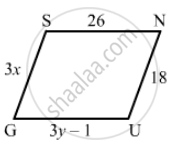Advertisements
Advertisements
प्रश्न
Two adjacent sides of a parallelogram are 4 cm and 3 cm respectively. Find its perimeter.
उत्तर
\[\text{ We know that the opposite sides of a parallelogram are equal } . \]
\[\text{ Two sides are given, i . e . 4 cm and 3 cm } . \]
\[\text{ Therefore, the rest of the sies will also be 4 cm and 3 cm }. \]
\[ \therefore \text{ Perimeter = Sum of all the sides of a parallelogram }\]
\[ = 4 + 3 + 4 + 3\]
\[ = 14 \text{ cm }\]
APPEARS IN
संबंधित प्रश्न
Name the quadrilaterals whose diagonals are perpendicular bisectors of each other
In the following figure GUNS and RUNS are parallelogram. Find x and y.

ABCD is a parallelogram in which ∠A = 70°. Compute ∠B, ∠C and ∠D.
Which of the following statement is true for a rhombus?
It has two pairs of parallel sides.
State with reason whether the following statement is ‘true’ or ‘false’.
Every rhombus is a rectangle.
Lengths of diagonals of a rhombus ABCD are 16 cm and 12 cm. Find the side and perimeter of the rhombus.
In rhombus ABCD;
(i) if ∠A = 74° ; find ∠B and ∠C.
(ii) if AD = 7.5 cm ; find BC and CD.
A quadrilateral whose all sides are equal, opposite angles are equal and the diagonals bisect each other at right angles is a ______.
In the figure, BEST is a rhombus, Then the value of y – x is ______.
ABCD is a rhombus such that the perpendicular bisector of AB passes through D. Find the angles of the rhombus.
Hint: Join BD. Then ∆ABD is equilateral.
